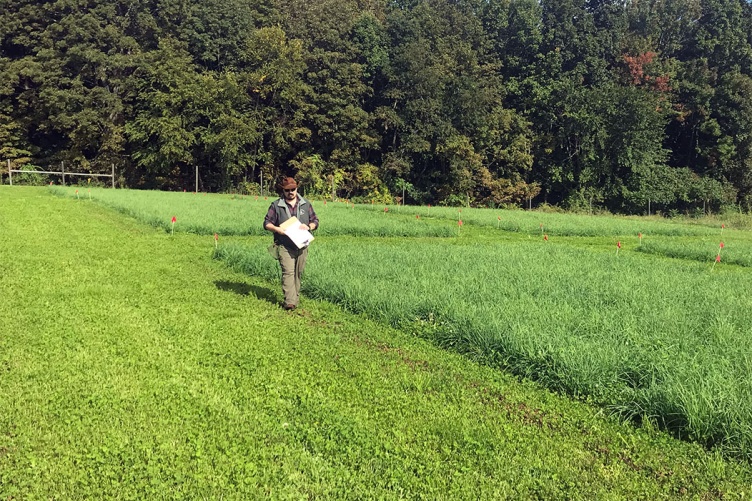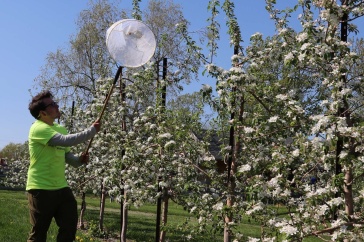Key Research Finding
Cutting forage crops like grasses and legumes more often can lead to increases in the amount of carbon in the soil and greater soil health. The research found that five cuttings per year resulted in increased soil carbon pools when compared with three cuttings per year.
Key Terms
Carbon pools: Refers to the various forms of organic matter storage compartments within the soil where carbon is sequestered and stored, contributing to soil fertility, structure, and overall ecosystem health. Expand for more information
These pools include living organisms, decomposing plant and animal residues, and stable organic matter, all of which influence soil's capacity to retain moisture, nutrients and support healthy plant growth.
Defoliation: The process of removing or losing the leaves of a plant. Expand for more information
This can occur naturally due to factors like seasonal changes, pests, diseases or extreme weather conditions, or it can be a deliberate agricultural practice carried out by farmers or gardeners for various reasons. In livestock farming, grazing animals like goats and cattle can defoliate plants by consuming their leaves. Farmers can also cut these plants to feed their livestock during other periods of time. Proper management of grazing or haying is essential to prevent over-defoliation, which can harm the vegetation and ecosystem.
Hydrolytic enzymes: Also known as hydrolases, they are a class of enzymes that catalyze chemical reactions in which water molecules are used to break down large molecules into smaller ones by cleaving specific chemical bonds. Expand for more information
Hydrolytic enzymes play a crucial role in various biological processes, such as cellular waste removal and the recycling of complex organic compounds.
Perennial forage systems: An agricultural or farming system focused on cultivation and management of perennial (i.e., continually occurring) forage crops for feeding livestock. Expand for more information
In this system, farmers grow and maintain perennial plants, such as certain types of grasses and legumes, which provide a consistent source of feed for livestock year after year. Perennial forage systems are commonly used in livestock farming, particularly for cattle, sheep, and goats.
Soils are fundamental to food production and for the 97 percent of New Hampshire farms that are small family-owned and operated businesses, proactively managing and ensuring healthy, productive soils is key to long-term sustainability and viability in the face of weather and market uncertainties. Organic matter-rich soils that help farms—by, for example, reducing their need for additional fertilizers—also benefit the ecosystems and watersheds that surround those agricultural businesses. Recent research by New Hampshire Agricultural Experiment Station (NHAES) scientists Jessica Ernakovich, Rich Smith and Serita Frey adds to the best practices food producers can use to increase carbon in soils by more frequent cuttings of legume-grass pasture lands—a practice that can more effectively cycle carbon and other nutrients into the soil.
“These findings improve our understanding of how agricultural practices affect soil organic matter and demonstrate how agricultural soil can sequester carbon from the atmosphere, helping New Hampshire farmers to apply more sustainable management practices,” said Cristhian dos Santos Teixeira, a UNH postdoctoral researcher and lead author of the study. “More soil organic matter is associated with higher water-holding capacity and nutrient availability, reducing the need for synthetic fertilizers, which lowers production costs.”
The research team assessed how the cutting frequency of pasture grasses and legumes impacted soil carbon levels and carbon cycling—the process of moving carbon between plants, animals and microbes; minerals in the earth; and the atmosphere, according to the Department of Energy. By comparing the frequency of cuttings—three times per year versus five times per year—the researchers found that increased cuttings resulted in an increase in areas where carbon is stored in the soil, or organic carbon pools. The more frequent cuttings increased the activity of the enzymes responsible for breaking down organic matter in the soil and ultimately improving soil quality and health.
“We know that soil organic matter is critical to the cycling of nutrients and can help buffer cropping systems against the effects of drought and extreme rainfall, both of which are occurring more frequently because of climate change.” ~ Rich Smith, professor of Natural Resources and the Environment
The paper was published in Plant and Soil, which, in addition to Teixeira, was co-authored by associate professor Ernakovich, professors Smith and Frey, and a team of other scientists in the UNH College of Life Sciences and Agriculture. The findings are particularly relevant to New Hampshire’s livestock producers who can more effectively plan and adjust their animals’ grazing schedules to bolster soil health and improve forage production.
According to Smith, identifying agricultural management practices that lead to an increase in and greater retention of soil carbon levels offers several advantages.
“We know that soil organic matter is critical to the cycling of nutrients and can help buffer cropping systems against the effects of drought and extreme rainfall, both of which are occurring more frequently because of climate change,” described Smith. “Additionally, we know that agricultural practices that take up and store more carbon in the soil will help reduce the amount of carbon in the atmosphere, which is the primary driver of climate change. So ultimately, there is the potential to create a positive feedback loop that will not only benefit farmers, but the environment and society at large.”
“In the future, we hope to examine the importance of legume types and the ratio of legumes to grass to offer additional insight into the varying impacts of defoliation frequency,” said Teixeira. “It’s also important to determine the longevity of the effect of defoliation on soil health, as we are searching for management practices that are beneficial to soil health in the long term.”
This material is based on work supported by the NH Agricultural Experiment Station through joint funding from the USDA National Institute of Food and Agriculture (under Hatch award numbers 1026297, 7000871 and 1016134) and the state of New Hampshire. Additional funding came from USDA NIFA Organic Transitions Program (Project No. 2016–51106-25713) and the Organic Agriculture Research and Extension Initiative (Project No. 2020–51300-32196) programs, and from Coordenação de Aperfeiçoamento de Pessoal de Nível Superior - Brasil (CAPES)
This work is co-authored by Cristhian dos Santos Teixeira (G’), Buck Castillo, Lukas Bernhardt (G’), Nick Warren, Claudia Petry, Jessica Ernakovich, Rich Smith and Serita Frey.
Read the published article, Frequent defoliation of perennial legume‑grass bicultures alters soil carbon dynamics, in Plant and Soil.
-
Written By:
Maeve Gifford | UNH College of Life Sciences and Agriculture | Maeve.Gifford@unh.edu



















































